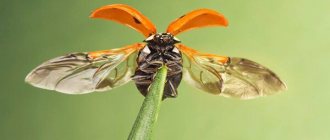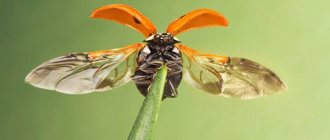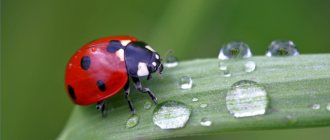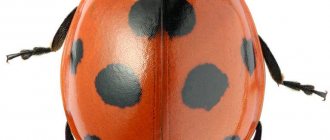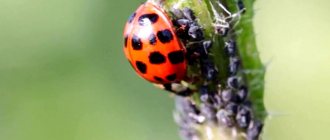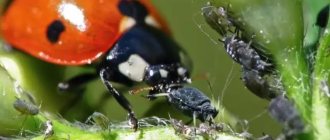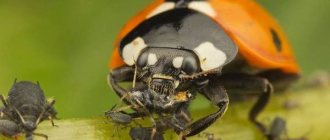Many of us are familiar with the bright and cute insect called the ladybug.
This is an arthropod insect belonging to the family of the same name. Coccinellidae (Latin) refer to Coleoptera.
History of the name
The insect received its unusual name due to its colorful and unusual colors. Translated from Latin, the word “coccineus” means scarlet. This is the color that is present in the color of most insects of the above family.
This insect received the second part of the name, namely the designation “God’s”, from people who had a certain honor and high respect for it.
Residents of Germany nicknamed it “Virgin Mary’s bug,” which is written in Latin as Marienkaefer. In the Czech Republic and Slovakia, the insect was nicknamed “Sun,” and Latin Americans gave it the name “St. Anthony’s ladybug.”Experts cannot say exactly how the Russian name for this insect appeared. There are only a few assumptions and the most popular versions.
Some firmly believe that the ladybug was named so because when the bug is in danger, it secretes a special liquid that is associated with milk.
It is worth noting that this reaction scares away predators.
There is also an opinion that people gave the insect a cute name due to the fact that a group of insects can save a crop from destruction by eating harmful aphids.
Where does the ladybug live?
The ladybug lives almost everywhere except the Arctic and Antarctic. Ladybug lives on trees, bushes and grass in different parts of the world. Most often, the ladybug lives in the steppe zone, forests, mountains and gardens. In Russia, the ladybug lives almost throughout the entire territory, with the exception of the extreme northern regions. The ladybug also lives in Europe, Asia, Japan, China, India, Mongolia, Africa, Korea and America.
Are there any enemies?
As stated above in the article, to protect against various enemies (birds, predatory insects and other natural enemies), ladybugs produce a special yellow liquid. This is a poison with a pronounced, unpleasant odor. Insects also repel ill-wishers thanks to their bright, flashy colors.
Experts note that ladybugs feel safe, because few other insects or animals can harm them.
However, in the natural kingdom there are enemies who are not afraid of either the poison or the color of ladybugs. The most dangerous enemies for them are dinocampuses.
They seek out adults and use their bodies as containers for their own eggs. They also parasitize pupae.
Types of ladybugs
Zoologists identify 4,000 different species of ladybugs, divided into 7 subfamilies. We will describe the most interesting among them.
Two-spot ladybird
This is a beetle with a body length of up to 5 mm, with a dark red body and two black dots (hence the name).
Blue
These mutated cows live only in Australia.
Thirteen-spotted ladybird
This type of ladybug has as many as 13 spots against the background of red-brown elytra; some of its spots can merge with each other.
Seven-spotted ladybird
It is this type of ladybug that is most common in Europe. Its size is 7-8 mm. Its elytra are painted red, there are three black spots on the sides, the seventh
Located near the insect's head.
Seventeen-spotted beetles
Seventeen-spotted beetles are the smallest, measuring up to 3.5 mm, and have a bright yellow back with a scattering of tiny dots.
Among all types of ladybugs, the 24-pointed shape stands out. These small beetles (3-3.5 mm) not only do not destroy pests, but they themselves eat the harvest of cucumbers, beets and many other crops.
The “evil ladybug,” like the Colorado potato beetle, eats not only fruits, but young shoots and leaves of plants.
Asian
Asian ladybugs grow up to 7 mm. This species is divided into 2 subspecies, differing in their coloring. One variety has black elytra, and on them there are red-rufous and pale yellow spots. The second one has dark dots of different sizes on a yellow background. As the name implies, representatives of this species live in Asia.
Fourteen-spotted ladybugs
Fourteen-spotted ladybugs have black or yellow elytra.
Pointless ladybug
This is a very rare species; its characteristic feature is the absence of signature spots. Also, the red or brown body of the pointless ladybug is covered with small fibers.
Ocellated
Representatives of this species are among the largest ladybugs. Their size can reach 11 mm. The beetles have an original color - the yellow or orange elytra of the ladybug are painted with black spots framed by a light stripe. There are 20 such spots in total.
Signs for girls
The ladybug, revered by our ancestors, is still perceived as a harbinger of future positive changes. The bug is greeted with special warmth by unmarried girls.
The sign says: if you are lucky enough to find a ladybug at home, you need to carefully hold it in your palm and take it outside.
Girls can use the bug as a navigator. Unclenching your hand, you need to see where the insect goes. Based on the flight path, you can determine where the betrothed will come from and where love will be found. If the spotted insect rose straight up to the sky, it means that the groom is somewhere nearby.
The appearance of a ladybug marks positive changes in a person’s destiny. Therefore, having noticed a bug, you need to remember the good omens, tune in to the positive and prepare for the gifts of fortune.
Signs about insects indoors
A ladybug in the house is a good omen. A bug that flies into the apartment of a married couple who has no children in the fall will soon bring a long-awaited addition. If the sonorous laughter of children is already heard in the house, it means that the kids will grow up healthy and friendly.
If a bug has flown into an apartment or house , this indicates the high moral principles that prevail in the family. It has been noticed that the insect more often enters houses with positive energy. There is no need to drive away the insect that has come to visit. This can bring misfortune to family members. It is enough to plant a bug on a houseplant near an open window, and the insect will fly away on its own, without staying in the house for long.
If a ladybug flew into a child's room and landed on the crib , the baby will grow up healthy and happy. A bug sitting on the marital bed prophesies a strong relationship and mutual love.
A bug that flies into the house in the morning will contribute to the search for a long-lost item . The appearance of a bug in an apartment during the day foreshadows a visit from guests. A cow crawling along the windowsill in the evening is a good omen, predicting pleasant leisure time with your family.
If someone is sick in the house, the traces of yellow secretion left by the insect promise a speedy recovery. The same marks left by a bug on a window foreshadow a visit from a distant relative. If you see yellow marks on the table, get ready for an increase in income.
Signs and beliefs by season
If a ladybug flies into the house, regardless of the time of year, this is a good omen. But still, the season matters, because finding an insect in winter or late autumn is very rare.
in spring
The appearance of a bug in an apartment in the spring is a favorable sign. At this time of year, ladybugs provoke a significant influx of financial resources by their appearance. This could be a salary increase, an unexpected bonus, or a lottery win.
In summer
According to legend, if a ladybug flies in in the summer, you should expect career growth. The bug must be carefully placed in the palm of your hand, taken outside and released. If the cow flies away right away, a promotion is just around the corner.
in autumn
Usually in the fall, insects, anticipating the onset of cold weather, look for warm shelters. If a ladybug flies into the house, get ready for a surprise - the family is expecting a new addition. Meeting a bug on the street foreshadows the resolution of conflicts in the family.
in winter
Ladybugs are rare in winter, as they hide from frost in the bark of trees and in other secluded corners. If a bug visited an apartment, most likely it was hiding from the cold under the windowsill.
After the unexpected appearance of an insect with red spotted wings, you should prepare for an encounter that will change your fate . When cows appear within the walls of a house in winter, they predict an acquaintance with a person who will have an impact on their personal life or career.
There is an alternative interpretation of the sign. Ladybugs fly into the apartment, warning the owners about a sudden visit from a dear relative who has not visited for a long time.
Another sign says that an awakened cow found in an apartment in winter is a sign of the imminent marriage of one of the older children in the family.
